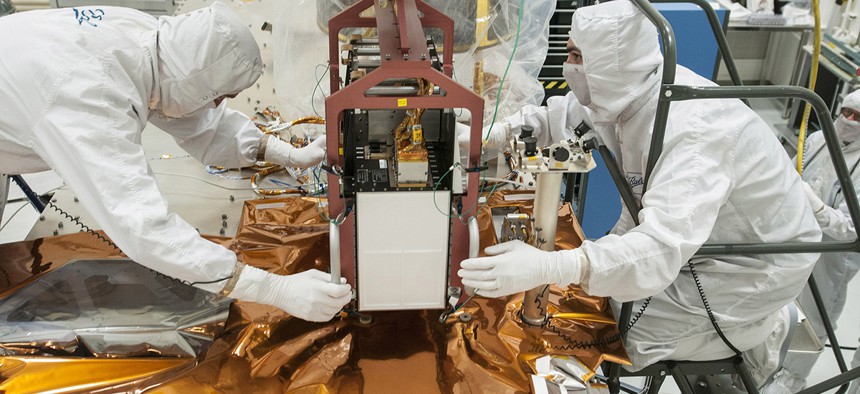NOAA’s New Environmental Satellite Launch Delayed 4-6 Months

Technicians work on the JPSS spacecraft. NOAA
The decision came after a NOAA-convened team conducted a risk-based evaluation of cost, schedule and performance issues for JPSS-1.
The National Oceanic and Atmospheric Administration will postpone the March 2017 launch of the first satellite in the $10 billion Joint Polar Satellite System another four to six months.
NOAA spokesman John Leslie confirmed the delay to Nextgov, which previously reported about the potential delay because of two unrelated challenges: issues with the satellite’s onboard instrumentation and problems with ground systems that will relay data to and from the satellite when it becomes operational.
The decision came after a NOAA-convened Independent Integration Team conducted a risk-based evaluation of cost, schedule and performance issues for JPSS-1.
» Get the best federal technology news and ideas delivered right to your inbox. Sign up here.
Emails from NOAA officials obtained by Nextgov suggest the environmental agency is confident the Suomi NPP—a modified demonstration satellite nearing the end of its life expectancy—and three additional legacy satellites are performing well enough to avoid a potential gap in weather data the Government Accountability Office has repeatedly warned Congress about.
Degradation of U.S. forecasts are likely to occur, however, if Suomi NPP fails before JPSS-1 is operational. NOAA estimates the fastest JPSS-1 will become operational is within six months of its launch.
Polar satellites are considered the backbone of NOAA’s global observing system, circling from pole-to-pole across the equator 14 times each day, providing a slew of meteorological information regarding the atmosphere, ocean and land.
The biggest ramifications to NOAA in a potential lapse in polar-orbiting satellite coverage would be the timeliness and accuracy of weather forecasts three to seven days prior to a severe weather event, such as the formation of a storm like Hurricane Sandy.
NEXT STORY: Video: Uber's Next Project: Flying Cars



